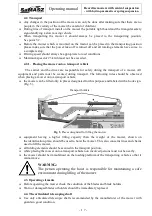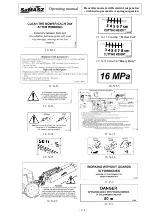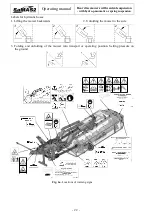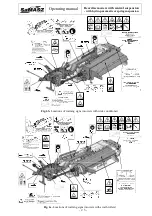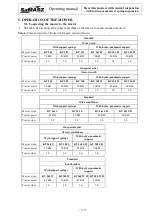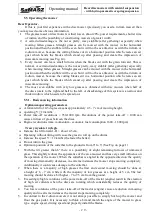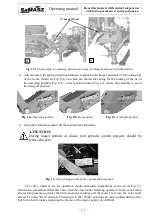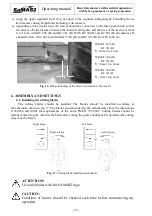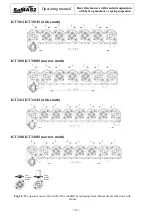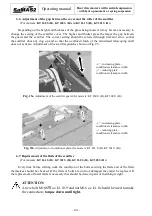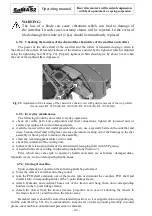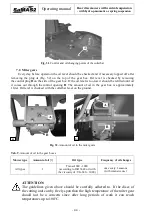
Operating manual
Rear disc mowers with central suspension
- with hydro-pneumatic or spring suspension
- 2 9 -
5.5.
Operating the mower
Dear Operator,
If this is your first experience with a disc mower (previously you used a 2-drum mower) then
you may need some obvious information:
1.
The greatest asset of disc mowers is their lower, about 20%, power requirements, shorter time
of inertia, and the possibility of constructing mowers of greater width.
2.
A certain disadvantage is the not as pretty, wavy stubble (after gathering) especially when
mowing fallen grasses. Straight grasses can be mowed with the mower in the horizontal
position and then the stubble will be even but it will not be as attractive as with the 2-drum or
4-drum mower, because the cutting blades cut in a horizontal position which creates an air
gust which bends the blades which stand up after passing and create the impression of
inaccurate mowing (see Fig. 14).
3.
Every mower can leave small furrows when the blades cut with the grain forward. This is
normal. A certain disadvantage is the not as pretty, wavy stubble (after gathering) especially
when mowing fallen grasses. Straight grasses can be mowed with the mower in the horizontal
position and then the stubble will be even but it will not be as attractive as with the 2-drum or
4-drum mower, because the cutting blades cut in a horizontal position which creates an air
gust which bends the blades which stand up after passing and create the impression of
inaccurate mowing.
4.
The most even stubble with very low grasses is obtained with disc mowers when half of
the discs rotate to the right and half to the left. A disadvantage of this system is a narrow and
thick windrow which needs to be spread out.
5.5.1.
Basic mowing information
Optimum operating parameters
A forward tilt of 0-5 degrees means approximately 4.5 - 7 cm of mowing height.
operating V
≥
10 km/hr.
Power take-off revolutions = 950-1000 rpm. Revolutions of the power take-off > 1000 can
cause a furrow of grass between the discs.
Engine revolutions (max. momentum - economic fuel consumption 1600 - 1800 rpm).
Trawy wysokie i wyległe
Increase the tilt forward - H = about 4.5 cm.
Operating without tilting will cause the grass to roll up on the drums.
Increase the speed V > 12 km/hr (the faster the better).
Do not turn in the grass.
Optimum position of the cutterbar to the ground is from 0° to 5° (See Fig. on page 1).
1.
With the tilt greater than 6° there is a possibility of slight remaining furrows of unmowed
grass. This slightly reduces the appearance of the area mowed and has very small influence on
the operation of the mower. When the cutterbar is angled in the opposite direction the quality
of mowing dramatically decreases, in extreme instances the mower stops mowing completely.
Additionally it could cause damage to the cutterbar.
2.
When there is a majority of high grasses the first and second mowing should be done at
a height of 6 - 7 cm, while with the majority of low grasses at a height of 5 cm. The last
mowing should be done a bit higher - 7 to 7.5 cm from the ground.
3.
Exceedingly high revolutions of the power take-off of the tractor (engine) result in the creation
of high air currents when the discs are rotating which considerably reduces the quality of
mowing.
4.
Too low revolutions of the power take-off of the tractor (engine) cause a reduction in mowing
quality and in extreme instances the mower stops mowing completely.
5.
In contrast to the 2-drum mowers it is not always possible to simply hitch up the mower and
floor the gas pedal. It is necessary to think a bit and match the angle of the mower to grass
type, engine speed, driving speed and properly install the blades.



